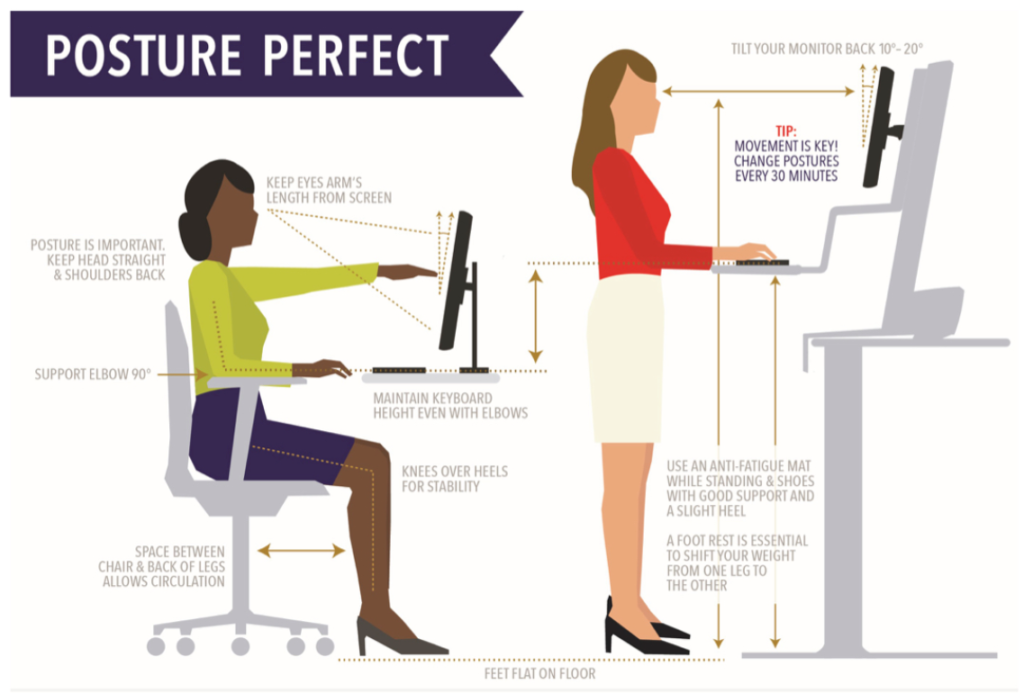
How many hours a day do you spend sitting down? How much of that time is spent in front of a screen?
According to the Nielsen ratings agency, Americans over the age of 18 spend approximately ten and a half hours a day on their smartphones or other electronic devices, watching television, or listening to the radio.
This ten plus time period also includes doing something else at the same time (e.g. cooking dinner while watching TV), but a lot of our time on electronic devices is also spent sitting.
This report was released during 2019. And let’s face it… I am sure the amount of time sitting in front of screens has increased since then as many of us have moved from working in offices to working from our kitchen tables.
Whether working from the office or at home, the fact remains that the majority of us spend most of our days sitting. Whether you are at a desk, table or in your car, it is important to keep in mind the importance of sitting correctly.
WHAT DOES GOOD SITTING POSTURE LOOK LIKE?
While it isn’t realistic to be thinking about your posture all the time, a level of awareness can encourage some lasting habits that result in prolonged changes. Once your muscles are retrained, you won’t have to give your posture as much thought because it will become your new normal.
So what does it look like when you are sitting properly?
When sitting correctly, your back should be upright with your shoulders pulled back, and your butt should be against the back of the chair. This will result in a natural curve in your lower back.
Your knees should be at level with your hips and your feet resting flat on the floor. Hips, knees and ankles should be at right angles and your weight should be evenly distributed between both hips.
Some positions that signal poor posture while sitting include:

- Chin jutting forward
- Slouching shoulders
- Back curved in a “C” shape
- Legs crossed
- Head leaning to one side
- Elbows bearing your weight
We’ve all heard that sitting is the new smoking. While there is an element of truth to this, sitting itself is not inherently bad. Sitting for hours at a time (especially when doing so with poor form) is.
Our bodies were designed to sit, but they were also designed to move. To help counter the effects of sitting, it is essential to get up and move around or stretch every 20-30 minutes.
If you want to have a better understanding of posture in general, you can find out more by checking out my previous blog post on why posture is important.
Five Tips to Improve Your Sitting Posture
Maintaining good posture is a habit, one that requires practice and consistency. Here are a few things you can do to help maintain good form while sitting.
Position hips, knees, and feet
Establishing the position of your lower body is the first step toward sitting properly. Your knees should be at a ninety-degree angle. Your hips can be a bit more open and your balance should be equally distributed between them.
Keep your feet flat on the floor. If they don’t reach the ground naturally, try using a footrest or place a book or something similar under them. Try to avoid twisting your ankles, crossing your legs or resting the outside of your feet on the floor.
Sit upright
On the bottom of your pelvis are two bones known as sitting bones. For ideal body alignment and transfer of weight when sitting, your body should be right on top of these bones, not in front or in back of them.
If your body weight leans forward then your low back may be arched. This can result in tightening of the muscles. If your body weight leans back, then you are likely slumping. Slumping can cause strain or pain and can ultimately lead to disc injury.
To rest correctly on top of your sitting bones, gently rock back and forth on them. After a few iterations, pause in the center, between the two end positions.
Preserve lower lumbar curve
The spine has natural curves in several locations that help to hold an upright posture. When viewed in profile, you can see a slight curve that sweeps forward in the low back.
If you are sitting with proper posture then you should be able to slide a hand in the space between the back of the chair and your low back.
As mentioned earlier, potential issues (like spasms or muscle strains) may arise when you over-arch the low back. If you find that you are prone to over-arching your back, try to sit with your pelvis in a neutral position. You may discover this helps you rest properly on top of your sitting bones, too.
On the other hand, if you slump you might benefit from some lumbar support. A lumbar roll resting between your low back and the back of the chair may support your natural curve Or, if your chair already has built-in lumbar support, don’t be afraid to use it!
Align shoulders
Are your shoulders bunched up by your ears? This is a very common position to find yourself in when you are seated. Having your shoulder blades lower can help support your head and neck.
For good sitting posture, you want your shoulders to be in vertical alignment with your hips, not behind them or in front of them. This should occur somewhat naturally if you are sitting upright.
Hold head back
When you sit in a supportive position, you will find that any tension held in your shoulders will be released. To sit properly, bring your head back so that your ears are in alignment with your shoulders.
If you have pain or limitations, this may not be fully possible. If so, that is fine, just don’t force it. The point is to do what you can within your range of motion and limitations, and to make incremental changes that will ultimately get you into a good seated position.
While these are all things that you can do on your own, you will find that things like your chair or work station can also impact how you are sitting, and you probably don’t even notice!
What Are You Sitting On?
What you sit on makes a difference. Is your chair cushioned or hard and flat? Does the seat dip? Does it have lumbar support? These factors can all affect your seated position in ways that result in poor posture in the long run.
For example if a chair has a seat that dips or slants, it can cause problems. A dip in the seat can encourage you to slump at the low back. Likewise, a slanted seat forces you to sit at an angle, making it harder to hold the positions outlined above.
If your seat is not level, try to sit close to the edge. Sitting close to the edge can offer a balanced, stable platform on which you can work on your proper sitting posture!
A chair that is adjusted correctly can also reduce strain on your back. If possible, get a chair that is easily adjustable so you can change the height, tilt and back position.
There are a number of ergonomic chairs out there for consideration, but I will save that for another post.
A lot of us are working from home nowadays which for many can mean sitting for hours on end at the kitchen table working on a laptop with a small screen. This is not ideal. In fact, you can’t work on a laptop while maintaining good posture.

Ultimately, you should try to set up a proper work station so that you can avoid strain and possible injury by making sure you are set up for success!
So what does that look like?
Adjust the height of your chair so that you can use the keyboard with your wrists and forearms straight and level with the floor. This can help prevent repetitive strain injuries.
Your elbows should be at your side with your arm forming an L-shape at the elbow.
Place your keyboard directly in front of you, leaving a gap of about 4 to 6 inches at the front of the desk to rest your wrists.
Keep your mouse close, too. A mat with a wrist pad may help keep your wrist straight and avoid awkward bends.
Your screen should be directly in front of you with the top of the monitor or screen at eye level. (You may need a monitor or laptop stand to achieve this.) Best practice is to have the monitor about an arm’s length away.
If the screen is too high or too low, you’ll have to bend or crane your neck, which can be uncomfortable and create strain.
Any frequently used items should be within easy reach as well. Objects such as your telephone or stapler should be simple to grasp. It can also help to vary the location of these items so that you are not always performing the same movements in the same directions.
Many people are opting to use standing desks to help break up all of the sitting they do during the work day. This is also something I look to address in the near future with another post.
Lastly, as mentioned earlier, it is important to take regular and frequent breaks. Don’t sit in the same position for more than 30 minutes if possible, ideally 20 minutes.
Make sure you change your position as often as possible and get up and move. Frequent breaks give your muscles a chance to relax!
Remember that good posture is a habit and habits take time to develop. Be sure to practice this technique for good sitting posture every day!
Need Some Professional Help?
While everything I have outlined here is a good place to start, this is by no means meant to be a comprehensive guide. Every single body is different and so is everyone’s posture.
Maybe you are not able to sit correctly due to lack of mobility or issues with chronic pain. For these reasons, it is best to get customized exercises that address your specific imbalances.
If you are interested to see if posture therapy can help with any chronic pain issues you may have, please contact me or schedule a free discovery session to find out if Pain Free Philly is a good fit for you.
With a little help and guidance, sitting can become a pain-free activity and you can get back to a life that moves you!
